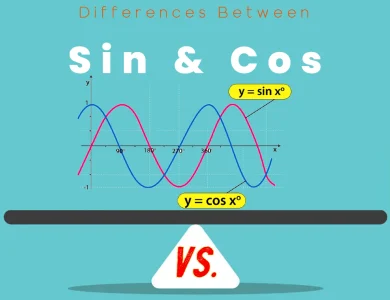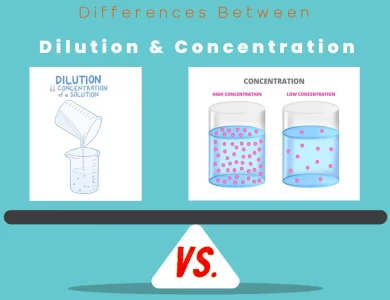- Mathematics

Differences Between Sin and Cos
Embarking on a journey through the realm of trigonometry, the distinctions between sine (sin) and cosine (cos) functions come to light. Beyond their fundamental definitions—sin(θ) representing the ratio of opposite to hypotenuse and cos(θ) signifying adjacent to hypotenuse—lies a rich tapestry of contrasts. Graphically, the sine function unfolds as an oscillatory wave, initiating at zero, reaching peaks, descending to troughs, and perpetually repeating. Conversely, the cosine function, while sharing similarities, exhibits a phase shift, starting at its peak and following a cyclical pattern. These nuances extend to real-world applications; sine finds resonance in harmonic motion and AC circuits, while cosine excels in scenarios with phase shifts, prevalent in physics and control systems. The symmetrical disparities, odd nature of sine, and even characteristics of cosine, reverberate through trigonometric identities and mathematical manipulations. Integrating and differentiating these functions brings forth sign alternations, adding another layer to their intricate relationship. As we navigate their shared frequency, periodicity, and delve into Euler's formula, a profound connection emerges, expressing these functions in the language of complex analysis. Unveiling the differences between sine and cosine functions not only enriches our understanding of trigonometry but also illuminates their pivotal roles in diverse mathematical landscapes and real-world scenarios.
- Cookery

Kung Pao vs Szechuan
Chinese cuisine is a world of culinary wonders, and two of its most iconic representatives, Szechuan and Kung Pao, offer a tantalizing journey for your taste buds. These distinct cuisines, both originating from China's Sichuan province, showcase remarkable contrasts in flavor profiles, cooking techniques, and regional variations. Szechuan cuisine, with its roots dating back over 2,000 years, is known for its audacious use of chili peppers and Szechuan peppercorns, delivering an intense heat and numbing sensation. The flavors are bold, the spice levels vary from moderately hot to scorching, and dishes like Mapo Tofu and Szechuan Hot Pot showcase the depth of complexity this cuisine offers. For those seeking a spicy adventure with a hint of the numbing thrill, Szechuan cuisine is the ultimate choice. Kung Pao cuisine, on the other hand, offers a more balanced flavor experience. While it's a subset of Szechuan cuisine, it tempers the heat with sweet, savory, and spicy elements in harmony. Kung Pao Chicken, a beloved classic, exemplifies this balance with its tender chicken, crunchy peanuts, and a delectable sauce. The heat in Kung Pao dishes is approachable, making it a favorite for those who prefer a milder yet still flavorful culinary journey. Join us as we delve deeper into the captivating world of Szechuan vs. Kung Pao, exploring their culinary techniques, dietary considerations, regional variations, and even the perfect beverage pairings. Whether you're a spice enthusiast or someone who relishes balance, you're bound to find your perfect Chinese cuisine match.
- Psychology

Metacognition vs Cognition
Cognition and metacognition, two intricate processes that govern the way we think and learn, often intertwine in our daily lives. While they share a common thread of influencing our cognitive abilities, they are distinct in their nature and functions. Cognition, the powerhouse of mental activities, encompasses a vast spectrum of processes—perception, memory, reasoning, language comprehension, and problem-solving. It's the force that drives us when we read, solve puzzles, or make decisions. Cognition acts as the cornerstone of understanding the world around us, laying the foundation for acquiring knowledge and adapting to an ever-changing environment. Metacognition, on the other hand, is the introspective guide to our cognitive processes. It's the awareness and control center, allowing us to think about our thinking. Metacognition enables us to monitor, regulate, and optimize our thought processes. Think of it as the voice inside your head that assesses your understanding, sets goals, and fine-tunes your cognitive strategies. In this journey of exploration, we will delve into the distinctive contrasts between cognition and metacognition, shedding light on their roles, development, real-world applications, and how balancing these two mental forces can empower us in our quest for knowledge and personal growth. Join us in uncovering the captivating intricacies of the mind's inner workings.
- Physiology

Tubular Secretion vs Tubular Reabsorption
In the intricate realm of renal physiology, two fundamental processes, tubular reabsorption and tubular secretion, take center stage. These processes unfold within the nephrons of your kidneys, playing vital roles in maintaining your body's delicate balance. Tubular Reabsorption: Imagine it as a meticulous collector. Tubular reabsorption selectively reclaims valuable substances—water, glucose, ions, and more—from the initial filtrate and ushers them back into your bloodstream. This process ensures that essential components are retained, preventing waste and maintaining homeostasis. Tubular Secretion: Now, picture it as your body's diligent cleaner. Tubular secretion actively shuttles waste products, hydrogen ions, creatinine, and even certain drugs from your bloodstream into the renal tubules. This detoxification process is crucial for maintaining pH levels, eliminating unwanted substances, and ensuring your body's internal environment stays pristine. Together, these processes form an intricate symphony, orchestrated by your kidneys, to keep you in perfect balance. Understanding the nuances of tubular reabsorption vs. tubular secretion unveils the marvels of your body's internal regulation. So, let's dive deeper and explore the captivating differences between these two renal processes.
- Movements

Naxalite vs Maoist
The Maoist and Naxalite movements have left an indelible mark on India's political landscape, yet they differ significantly in various aspects. While both movements initially emerged from the Naxalbari region of West Bengal, their historical origins and ideologies set them apart. The Maoist movement draws inspiration from Mao Zedong's teachings and emphasizes armed struggle to establish a classless communist society. In contrast, the Naxalite movement began with a focus on land reform and expanded to address a broader spectrum of socio-economic concerns, including indigenous rights and environmental issues. Geographically, both movements have found strongholds in the "Red Corridor" states, but their operational strategies diverge. The Maoist movement employs protracted people's war and guerrilla warfare tactics, while the Naxalite movement diversified to include mass mobilization and non-violent activities alongside armed struggle. These movements have also had varying impacts on India's political discourse and have raised concerns regarding human rights violations. Understanding these key differences sheds light on the complexities of these influential revolutionary forces in India.
- Psychology

Vygotsky vs Piaget
In the realm of child development and education, two prominent figures, Jean Piaget and Lev Vygotsky, have illuminated the path to understanding how children grow, learn, and construct knowledge. While both theorists share a common goal—to unravel the mysteries of cognitive development—their approaches and viewpoints diverge in significant ways. Piaget's Theory: Jean Piaget, a Swiss psychologist, is renowned for his constructivist theory of cognitive development. He posited that children actively construct their understanding of the world through a series of distinct, fixed, and sequential stages. In Piaget's world, development unfolds through individual exploration, with each stage building upon the cognitive accomplishments of the previous one. His theory underscores the universal and invariant nature of cognitive development, suggesting that all children follow the same developmental sequence. Vygotsky's Theory: Lev Vygotsky, a Soviet psychologist, presented a contrasting perspective rooted in sociocultural theory. Vygotsky's theory rejects the notion of fixed developmental stages. Instead, it centers on the Zone of Proximal Development (ZPD), emphasizing the role of social interaction and cultural context in cognitive growth. According to Vygotsky, learning and development are interwoven, and children thrive when they receive guidance and support from more knowledgeable individuals. His theory acknowledges the influence of culture, language, and social collaboration in shaping cognition. This blog will delve into these disparities, exploring how Piaget and Vygotsky differ in their views on language development, the role of play, assessment methods, and implications for education. By the end of our journey, you'll gain a comprehensive understanding of the rich tapestry of theories that underpin our comprehension of child development and education.
- Training

Training vs Orientation
When it comes to welcoming new employees into your organization, two crucial processes play a significant role in setting them up for success: orientation and training. While these terms are often used interchangeably, they serve distinct purposes and have unique characteristics. Orientation is the initial step in the onboarding process for new employees. Its primary purpose is to acquaint them with the organization's culture, policies, procedures, and the work environment. Think of it as the warm welcome you receive when you step into a new place; it's all about getting you comfortable and familiar with your surroundings. On the other hand, training goes beyond orientation and dives deeper into the specific skills and knowledge required for a particular role. It equips employees with the tools and competencies they need to perform their job effectively. Training is like the specialized training a soldier undergoes to prepare for their unique tasks on the battlefield. In this comprehensive guide, we'll explore the key differences between orientation and training, shedding light on their goals, content, duration, and outcomes. Whether you're a seasoned HR professional or a new hire trying to grasp the nuances of your onboarding journey, this article will provide you with valuable insights.
- Movements

Terrorist vs Militant
In the intricate world of conflict and security, distinguishing between militants and terrorists is paramount for a nuanced understanding of global events. While these terms are often used interchangeably in public discourse, they represent two distinct entities with contrasting goals, methods, and implications. Militants are individuals or groups engaged in armed struggles primarily for political, social, or religious reasons. Their motivations often revolve around addressing grievances, seeking autonomy, or striving for recognition. Militants typically employ conventional warfare tactics and tend to target military or government entities while avoiding direct harm to civilians. Their objectives can range from regional autonomy to full independence, and they may negotiate for political recognition or power-sharing arrangements. On the other hand, terrorists employ violence and fear to achieve ideological, political, or religious objectives. They deliberately target civilians and employ unconventional tactics such as bombings, kidnappings, and hijackings. Unlike militants, terrorists are often driven by uncompromising ideologies, making them less amenable to negotiation. Their actions are designed to create chaos and instability within societies, aiming to disrupt governance and provoke fear. As we delve deeper into the key distinctions between militants and terrorists, we uncover a complex web of motivations, tactics, and consequences that shape the landscape of contemporary global security. Understanding these differences is crucial for policymakers, security professionals, and the general public in addressing the multifaceted challenges posed by these two entities.
- Training

Training vs Internship
When it comes to shaping a successful career, understanding the disparities between an internship and training is pivotal. These two avenues offer unique opportunities for learning and skill development, each with its distinct characteristics and benefits. An internship is a practical learning experience that immerses individuals in real-world work environments. It's an excellent choice for students or recent graduates looking to bridge the gap between academic knowledge and practical application. Internships can vary in duration, often spanning from a few weeks to several months. They offer a chance to cultivate soft skills like communication and problem-solving, build professional networks, and gain valuable exposure to a specific industry. However, it's essential to note that internships can be paid or unpaid, with the compensation structure varying across organizations and regions. Training, on the other hand, is a structured educational program designed to impart specific knowledge and skills. It's suitable for individuals at various stages of their careers, from professionals seeking to upskill to career changers looking to acquire new qualifications. Training programs are typically shorter in duration compared to internships, ranging from a few days to several weeks. They focus on skill mastery and often lead to certifications, making participants more competitive in their respective fields. Unlike internships, training programs are usually fee-based, requiring participants to pay for their enrollment. In summary, the choice between an internship and training hinges on your career goals, financial situation, and preferred learning style. Internships emphasize real-world experience and networking, while training programs prioritize skill enhancement and certification. By understanding these key distinctions, you can embark on a path that aligns with your professional aspirations and sets you on the trajectory to success.
- General Chemistry

Concentration vs Dilution
In the realm of chemistry and everyday life, understanding the nuances between dilution and concentration is paramount. These two processes, seemingly at odds, play vital roles in various fields, from laboratories and healthcare facilities to kitchens and industrial settings. Let's delve into the world of "Differences Between Dilution vs Concentration." Dilution is a process that involves making a solution less concentrated by adding more solvent. The result is a reduction in the amount of solute per unit volume while keeping the total amount of solute constant. Dilution is akin to fine-tuning, allowing precise control over solution strength. It finds application in scientific experiments, where accuracy is paramount, as well as in healthcare, where medications are prepared at specific dosages tailored to individual patients. Dilution also plays a pivotal role in the food and beverage industry, where flavors and sweetness levels are adjusted to meet consumer preferences. Concentration, on the other hand, entails increasing the amount of solute in a solution, often by adding more solute substance or removing some of the solvent. Concentrated solutions boast a higher solute-to-solvent ratio, making them potent and ideal for various applications. Industries like chemical synthesis, food preservation, and pharmaceuticals rely on concentration to achieve desired results, from driving reactions to completion to preserving the shelf life of products.










